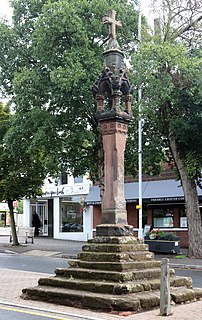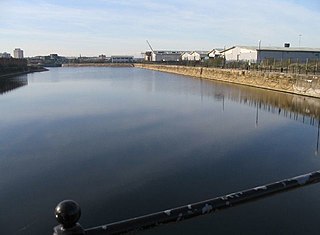
Merseyside is a metropolitan and ceremonial county in North West England, with a population of 1.38 million. It encompasses the metropolitan area centred on both banks of the lower reaches of the Mersey Estuary and comprises five metropolitan boroughs: Knowsley, St Helens, Sefton, Wirral and the city of Liverpool. Merseyside, which was created on 1 April 1974 as a result of the Local Government Act 1972, takes its name from the River Mersey.

The River Mersey is a river in the North West of England. Its name is derived from the Anglo-Saxon language and translates as "boundary river". The river may have been the border between the ancient kingdoms of Mercia and Northumbria and for centuries it has formed part of the boundary between the historic counties of Lancashire and Cheshire.

The Queensway tunnel is a road tunnel under the River Mersey, in the north west of England, between Liverpool and Birkenhead. Locally, it is often referred to as the Birkenhead tunnel or old tunnel, to distinguish it from the newer Kingsway tunnel (1971), which serves Wallasey and the M53 motorway traffic.

Birkenhead is a town in the Metropolitan Borough of Wirral, Merseyside, England; historically, until 1974, in Cheshire. It is on the Wirral Peninsula, along the south bank of the River Mersey, opposite the city of Liverpool. At the 2011 census, it had a population of 88,818.

Bromborough is a town within the Metropolitan Borough of Wirral, in Merseyside, England. Historically in the county of Cheshire, it is situated on the Wirral Peninsula, to the south east of Bebington and to the north of Eastham.
Merseytravel is the Passenger transport executive and Strategic Transport Advisor for the Liverpool City Region. Responsible for the coordination of public transport in Merseyside, North West England. Merseytravel was established on 1 December 1969 as the Merseyside Passenger Transport Executive. From 1 April 2014 Merseytravel expanded its area of operation from the metropolitan county of Merseyside to also include the Borough of Halton.

Tranmere is a suburb of Birkenhead, on the Wirral Peninsula, England. Administratively, it is within the Birkenhead and Tranmere Ward of the Metropolitan Borough of Wirral, in Merseyside. Before local government reorganisation on 1 April 1974, it was part of the County Borough of Birkenhead, within the geographical county of Cheshire.

Morpeth Dock is a dock at Birkenhead, Wirral Peninsula, England. The dock is situated between the River Mersey and Egerton Dock.
The Mersey Tunnels connect the city of Liverpool with Wirral, under the River Mersey. There are three tunnels: the Mersey Railway Tunnel, and two road tunnels, the Queensway Tunnel and the Kingsway Tunnel. The railway tunnel and Queensway Tunnel connect central Liverpool with Birkenhead, while the Kingsway Tunnel runs to Wallasey.

Wirral, also known as The Wirral, is a peninsula in North West England. The roughly rectangular peninsula is about 15 miles (24 km) long and 7 miles (11 km) wide and is bounded by the River Dee to the west that forms a boundary with Wales, the River Mersey to the east, and the Irish Sea to the north.

Herbert James Rowse was an English architect. Born in Liverpool and a student of Charles Reilly at the Liverpool University School of Architecture, Rowse opened an architectural practice in the city. Although he designed major buildings for other cities, Rowse is best known for his work in Liverpool, including India Buildings, the entrances to and ventilation towers of the Mersey Tunnel ("Queensway"), and the Philharmonic Hall. He designed in a range of styles, from neoclassical to Art Deco, generally with a strong American influence.

Birkenhead Priory is in Priory Street, Birkenhead, Merseyside, England. It is the oldest standing building on Merseyside. The remains of the priory are recorded in the National Heritage List for England as a designated Grade I listed building, and it is a Scheduled Ancient Monument.

Birkenhead Park is a major public park located in the centre of Birkenhead, Merseyside, England. It was designed by Joseph Paxton and opened on 5 April 1847. It is generally acknowledged as the first publicly funded civic park in the world. The park was designated a conservation area in 1977 and declared a Grade I listed landscape by English Heritage in 1995. The park influenced the design of Central Park in New York and Sefton Park in Liverpool.

Birkenhead Woodside was a railway station at Woodside, in Birkenhead, on the Wirral Peninsula, Cheshire. It was served by local services in Cheshire as well as long-distance services to southern England, including London.

Woodside is a small riverside locality in Birkenhead, on the Wirral Peninsula, England, situated almost opposite Liverpool Pier Head across the River Mersey.

Runcorn is a small industrial town in the borough of Halton, Cheshire, England. This list contains the 27 buildings that are recorded in the National Heritage List for England as designated listed buildings in the part of the borough lying to the south of the River Mersey outside the urban area of Runcorn. The area covered includes the villages of Clifton, Daresbury, Preston Brook, Preston on the Hill, and Moore. Three of the buildings in the area are classified as Grade II*, and the others are at Grade II; there are no buildings in Grade I. In the United Kingdom, the term listed building refers to a building or other structure officially designated as being of special architectural, historical, or cultural significance. These buildings are in three grades: Grade I consists of buildings of outstanding architectural or historical interest; Grade II* includes particularly significant buildings of more than local interest; Grade II consists of buildings of special architectural or historical interest. Buildings in England are listed by the Secretary of State for Culture, Media and Sport on recommendations provided by English Heritage, which also determines the grading.

The Grand Entrance to Birkenhead Park is at the northeast entrance to Birkenhead Park in Birkenhead, Wirral, Merseyside, England. It consists of three arches flanked by lodges and is in Ionic style. The entrance was designed by Lewis Hornblower, with amendments by Joseph Paxton, the designer of the park. The park, and its entrance, were opened in 1847. The Grand Entrance is recorded in the National Heritage List for England as a designated Grade II* listed building.

Birkenhead War Memorial, or Birkenhead Cenotaph, stands in Hamilton Square, Birkenhead, Merseyside, England, opposite the Town Hall. It consists of a cenotaph in Portland stone with carved figures and panels in Westmorland stone. The memorial was designed by Lionel Budden, and the sculptor was H. Tyson Smith. It was unveiled in 1925 by Lieutenant-General Sir Richard H. K. Butler. The memorial is recorded in the National Heritage List for England as a designated Grade II* listed building.

The Queen Victoria Monument stands in the centre of Hamilton Square, Birkenhead, Wirral, Merseyside, England. It is in the form of an Eleanor cross. The memorial was designed by Edmund Kirby, and was unveiled in 1905. It is recorded in the National Heritage List for England as a designated Grade II listed building.

Birkenhead is a town in Wirral, Merseyside, England. Its central area contains 149 buildings that are recorded in the National Heritage List for England as designated listed buildings. Of these, six are listed at Grade I, the highest of the three grades, six at Grade II*, the middle grade, and the others are at Grade II, the lowest grade. This list contains the listed buildings in the central area of the town, and the other listed buildings are to be found in separate lists.

















